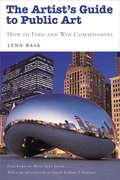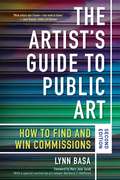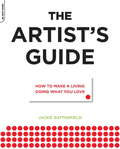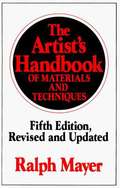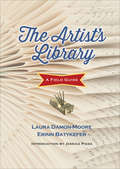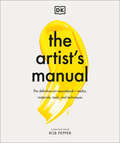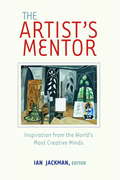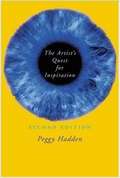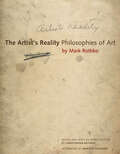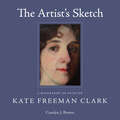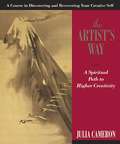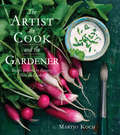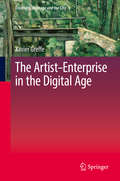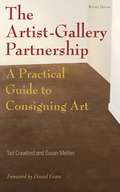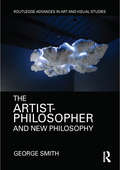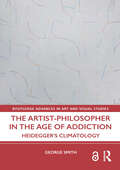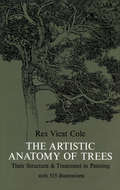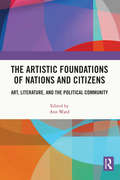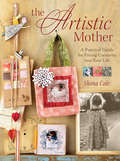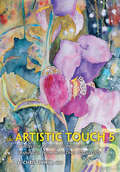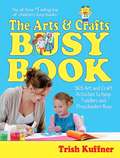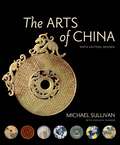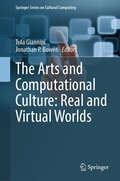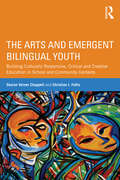- Table View
- List View
The Artist's Guide to Public Art: How to Find and Win Commissions
by Lynn BasaPublic art commissions--how to find them, how to get them. * First-hand advice from experienced public artists* Written by an artist for artists* Includes expert information on public art law Learn how to find, apply for, compete for, and win a public art commission. First-hand interviews with experienced public artists and arts administrators provide in-the-trenches advice and insight, and a chapter on public art law, written by Barbara Hoffman, the country''s leading public art law attorney, answers questions about this complex area. Packed with details on working with contracts, conflict, controversy, communities, committees, and more, "The ArtistOCOs Guide to Public Art "shows artists the way to cut through the red tape and win commissions that are rewarding both financially and artistically. "
The Artist's Guide to Public Art: How to Find and Win Commissions (Second Edition)
by Lynn Basa“What artists don’t know—but need to know.” —Jack Becker, Public Art ReviewA Comprehensive Guide to the Complex World of Public ArtLearn how to find, apply for, compete for, and win a public art commission. First-hand interviews with experienced public artists and arts administrators provide in-the-trenches advice and insight, while a chapter on public art law, written by Barbara T. Hoffman, the country's leading public art law attorney, answers questions about this complex area. Packed with details on working with contracts, conflict, controversy, communities, committees, and more, The Artist's Guide to Public Art, Second Edition, shows artists how to cut through the red tape and win commissions that are rewarding both financially and artistically. This new edition discusses recent trends in the field, such as: how the political climate affects public art, the types of projects that receive funding, where that funding comes from, how the digital age impacts public art, how to compete with the increase of architecturally trained artists, and more. Written by an artist, for artists, this guide is packed with everything readers need to know:Finding commissionsSubmitting applicationsNegotiating contractsBudgeting for projectsNavigating copyright lawWorking with fabricatorsAnd much moreFrom start to finish, Lynn Basa covers all the steps of the process. With The Artist's Guide to Public Art, Second Edition, even readers without prior experience will be more than ready to confidently pursue their own public art projects.
The Artist's Guide: How to Make a Living Doing What You Love
by Jackie BattenfieldUsing a "tough love approach" to pursuing a career in the visual arts, Jackie Battenfield expands on her highly successful classes and workshops to provide a comprehensive guide for both emerging and mid-career artists.Providing real-life examples, illustrations, and step-by-step exercises, Battenfield offers readily applicable advice on all aspects of the job. Along with tips on planning and assessment, she presents strategies for self-management, including marketing, online promotion, building professional relationships, grant writing, and portfolio development.Each chapter ends with an insightful "Reality Check" interview, featuring advice and useful information from high-profile artists and professionals.The result is an inspiring, experiential guide brimming with field-tested techniques that readers can easily apply to their own career.
The Artist's Handbook Of Materials And Techniques (Reference)
by Ralph MayerThe Artist's Handbook of Materials and Techniques is a reference book by Ralph Mayer (1895–1979). Intended by the author for use by professional artists, it deals mostly with the chemical and physical properties of traditional painterly materials such as oil, tempera, and encaustic, as well as solvents, varnishes, and painting mediums. It also has extensive coverage of ancillary activities such as stretching and preparing canvas, care and maintenance of tools, and conservation of older paintings. Originally published in 1940, the Handbook was referred to as "the painter's bible" at the time,[citation needed] and it continues to have a place on the reading list in American universities to this day. It underwent three extensive revisions in Mayer's lifetime, and the fifth posthumous edition is still in print. Ralph Mayer’s archives of writing and research on materials and techniques are now at the Ralph Mayer Learning Center, Yale University School of Art.
The Artist's Library: A Field Guide (Books In Action Ser.)
by Laura Damon-Moore Pigza Jessica Erinn BatykeferCreativity, like information, is free to everyone who steps into a library. The Artist's Library offers the idea that an artist is any person who uses creative tools to make new things, and the guidance and resources to make libraries of all sizes and shapes come alive as spaces for art-making and cultural engagement. Case studies included in the book range from the crafty (pop-up books) to the community-minded (library galleries) to documentary (photo projects) to the technically complex ("listening" to libraries via Dewey decimal frequencies).The Library as Incubator Project was created by Erinn Batykefer, Laura Damon-Moore, and Christina Endres. It highlights the ways that libraries and artists can work together, and works to strengthen these partnerships. By calling attention to one of the many reasons libraries are important to our communities and our culture, it provides a dynamic online forum for sharing ideas.Erinn Batykefer is a librarian, a writer, and a lifelong do-it-yourselfer. She earned an MFA in writing and a Master of Library and Information Studies from the University of Wisconsin-Madison. Her first poetry collection, Allegheny, Monongahela, won the Benjamin Saltman Poetry Prize.Laura Damon-Moore is a librarian, blogger, and avid art-maker in her spare time. Laura received her master's degree in Library and Information Studies from the University of Wisconsin-Madison in 2012.Jessica Pigza is the assistant curator in the New York Public Library's Rare Book Division. She also writes on handmade material culture, DIY, and handicrafts at Hand-Made Librarian.
The Artist's Manual: The Definitive Art Sourcebook: Media, Materials, Tools, and Techniques
by Rob PepperTake your creativity to the next level with the ultimate artist&’s bible! Covering everything from how to draw and paint to ceramics, sculptures and printmaking, you&’ll get the most out of your passion for art with this beautifully illustrated artist&’s handbook. It also includes newer areas like digital art and animation — perfect for modern artists!Discover everything you need to help you release the artist within: • All areas of visual and digital art, including drawing, painting, 3D art, printmaking, textiles and photography. • Each section is written by an acknowledged expert in that field — both practicing professionals and university-level teachers. • Comprehensive coverage of equipment and tools, including step-by-step sequences, where appropriate on how to use. • Techniques are illustrated in step-by-step sequences by professional artists, with basic skills leading on to more advanced techniques. • Gets to the heart of the matter and delivers the information quickly and authoritatively. Whether you&’re dipping in to find a specific painting technique or browsing for artistic inspiration, this artist&’s reference book covers all the elements of art. Brush up on the art basics like choosing the right tool, mixing watercolors and preparing a canvas. Take your skills further and learn how to glaze a pot, try out 3D printing and mosaic, or create a digital collage. The Artist's Manual will help you become a more confident, creative artist. Equipment, materials and methods are fully explained and beautifully illustrated. Perfect for artists of every skill level, you&’ll be creating your own masterpieces in no time with this sourcebook of art. It&’s a must-have for every artist&’s studio!
The Artist's Mentor: Inspiration from the World's Most Creative Minds
by Ian JackmanWhat inspires a person to create? How does an artist see the world? What happens during a "eureka moment?" How does an artist find self-discipline? The Artist's Mentor is for those of us who want to create art but do not know how to begin. Drawing on interviews and autobiographical writings of more than 100 famous painters, photographers, sculptors, and film and video artists, Jackman gets to the heart of what makes art. Here, Michelangelo Brungardt, Frida Kahlo, Jean Renoir, Andy Warhol, Ansel Adams, Annie Leibowitz, Pablo Picasso, and many other visual artists describe the creative process. Quotes and passages from the artists are accompanied by commentary from Jackman.
The Artist's Quest of Inspiration
by Peggy HaddenUpdated to inspire a new generation of visual artists in their quest for creative growth, this book shows artists how they can experience a new awakening of creativity and add fresh meaning to their work by using simple techniques found in this inspirational guide. A working artist who has coped successfully with the daily challenge of facing a blank canvas shares her methods for overcoming creative blocks.Allworth Press, an imprint of Skyhorse Publishing, publishes a broad range of books on the visual and performing arts, with emphasis on the business of art. Our titles cover subjects such as graphic design, theater, branding, fine art, photography, interior design, writing, acting, film, how to start careers, business and legal forms, business practices, and more. While we don't aspire to publish a New York Times bestseller or a national bestseller, we are deeply committed to quality books that help creative professionals succeed and thrive. We often publish in areas overlooked by other publishers and welcome the author whose expertise can help our audience of readers.
The Artist's Reality: Philosophies of Art
by Mark RothkoMark Rothko&’s classic book on artistic practice, ideals, and philosophy, now with an expanded introduction and an afterword by Makoto Fujimura Stored in a New York City warehouse for many years after the artist&’s death, this extraordinary manuscript by Mark Rothko (1903–1970) was published to great acclaim in 2004. Probably written in 1940 or 1941, it contains Rothko&’s ideas on the modern art world, art history, myth, beauty, the challenges of being an artist in society, the true nature of &“American art,&” and much more. In his introduction, illustrated with examples of Rothko&’s work and pages from the manuscript, the artist&’s son, Christopher Rothko, describes the discovery of the manuscript and the fascinating process of its initial publication. This edition includes discussion of Rothko&’s &“Scribble Book&” (1932), his notes on teaching art to children, which has received renewed scholarly attention in recent years and provides clues to the genesis of Rothko&’s thinking on pedagogy. In an afterword written for this edition, artist and author Makoto Fujimura reflects on how Rothko&’s writings offer a &“lifeboat&” for &“art world refugees&” and a model for upholding artistic ideals. He considers the transcendent capacity of Rothko&’s paintings to express pure ideas and the significance of the decade-long gap between The Artist&’s Reality and Rothko&’s mature paintings, during which the horrors of the Holocaust and the atomic bomb were unleashed upon the world.
The Artist's Sketch: A Biography of Painter Kate Freeman Clark
by Carolyn J. BrownArtist Kate Freeman Clark (1875–1957) left behind over one thousand paintings now stored at a gallery bearing her name in her hometown of Holly Springs, Mississippi. But it was not until after her death in 1957 at the age of eighty-one that citizens even discovered that she was a painter of considerable stature. In her will, Clark left the city her family home, her paintings stored at a warehouse in New York for over forty years, and money to build a gallery, much to the surprise of the Holly Springs community. As a young woman, Clark studied art in New York and took classes with some of the greatest American artists of the day. From the start Clark approached the study of art with discipline and tenacity. She learned from William Merritt Chase when he opened his own school in 1895. For six consecutive summers at his Shinnecock Summer School of Art in Long Island, she mastered the plein air technique. Chase trained many female students, yet he recognized Clark as “his most talented pupil.” The book prints, for the first time, excerpts from Clark's delightful journal of the artist's experience at Chase's school, giving readers firsthand reporting of an artist-led school in the early twentieth century. Clark returned to Holly Springs in 1923. Mysteriously, sadly, she never resumed painting and lived the last years of her life in quietude. The Artist's Sketch shines a light on Clark, finally bringing her out of obscurity. This book also introduces Clark's art to a new generation of readers and highlights current projects and important work being done in Holly Springs by the Kate Freeman Clark Art Gallery and the Marshall County Historical Museum, the two institutions that, since her death, have worked hard to keep Kate Freeman Clark's legacy alive.
The Artist's Way, A Spiritual Path to Higher Creativity
by Julia CameronThe Artist's Way is the seminal book on the subject of creativity. An international bestseller, it's an invaluable guide to living the artist's life. Perhaps even more vital in today's cultural climate than when it was first published a decade ago, it is a powerfully provocative and inspiring work. In a new introduction to the book, Julia Cameron reflects on the impact of The Artists Way and describes her work over the last decade and the deep insights into the creative process she has gained. Now updated, this anniversary edition ushers The Artist's Way into a new century. JULIA CAMERON has been an active artist for more than thirty years. She is the author of seventeen books, fiction and nonfiction, including The Artist's Way, The Vein of Gold, and The Right to Write, her bestselling works on the creative process. A novelist, playwright, songwriter, and poet,she has multiple credits in theater, film, and television. She divides her time between Manhattan and the high desert of New Mexico.
The Artist, the Cook, and the Gardener: Recipes Inspired by Painting from the Garden
by Maryjo KochCreative recipes and celebrations of seasonal bounties—in the garden, in the kitchen, and on the canvas. Artist Claude Monet took inspiration from his gardens and the lily ponds at Giverny. Van Gogh, Manet, Matisse, and Cezanne created still life masterpieces of fruit and flowers. Similarly, cooks from Julia Child and Alice Waters to Patricia Wells and Jamie Oliver have taken culinary inspiration from homegrown or fresh local produce. Now artist Maryjo Koch explores this centuries-old connection in a new cookbook inspired by her studio garden. The garden not only provides the artistic subjects she and her students paint, but also serves as the culinary toolbox for the delectable and visual feasts she prepares for her family, guests, and painting classes throughout the year. Artists, cooks, and gardeners alike will find tips, recipes, and painting projects centered on seasonal food pairings. For example, the winter garden focuses on soups with offerings like Minestrone with Crumbled Bacon and Butternut Squash-Apple Soup. Springtime brings culinary attention to leafy greens such as Flower Petal Salad and Spring Asparagus Frittata with Peas and Peppers. As the seasons’ bounty progresses, the painting subjects and menus change as well, invented with whatever is freshest and most beautiful in the garden. Whether you find yourself more at home with an artist’s brush, a cook’s wooden spoon, or a gardener’s spade, you’ll find inspiration inside this lavish cookbook.
The Artist, the Cook, and the Gardener: Recipes Inspired by Painting from the Garden
by Maryjo KochCreative recipes and celebrations of seasonal bounties—in the garden, in the kitchen, and on the canvas. Artist Claude Monet took inspiration from his gardens and the lily ponds at Giverny. Van Gogh, Manet, Matisse, and Cezanne created still life masterpieces of fruit and flowers. Similarly, cooks from Julia Child and Alice Waters to Patricia Wells and Jamie Oliver have taken culinary inspiration from homegrown or fresh local produce. Now artist Maryjo Koch explores this centuries-old connection in a new cookbook inspired by her studio garden. The garden not only provides the artistic subjects she and her students paint, but also serves as the culinary toolbox for the delectable and visual feasts she prepares for her family, guests, and painting classes throughout the year. Artists, cooks, and gardeners alike will find tips, recipes, and painting projects centered on seasonal food pairings. For example, the winter garden focuses on soups with offerings like Minestrone with Crumbled Bacon and Butternut Squash-Apple Soup. Springtime brings culinary attention to leafy greens such as Flower Petal Salad and Spring Asparagus Frittata with Peas and Peppers. As the seasons’ bounty progresses, the painting subjects and menus change as well, invented with whatever is freshest and most beautiful in the garden. Whether you find yourself more at home with an artist’s brush, a cook’s wooden spoon, or a gardener’s spade, you’ll find inspiration inside this lavish cookbook.
The Artist-Enterprise in the Digital Age
by Xavier GreffeThis book is a monograph of cultural economics of a new concept, artist-enterprises. It explores various dimensions that artists embody, i. e. , aesthetic, critical, messianic, and economic ones, and screens the multiple challenges faced by the artist-enterprises in terms of pricing, funding, and networking in the Digital Age. It shows how these artist-enterprises are at the core of the contemporary creative industries. Even when they are on their own, artists have to demonstrate or manage a variety of skills, sign contracts both in the early and later stages of their activities, and also maintain relationships and networks that enable them to attain their artistic and economic goals. They are no longer simply entrepreneurs managing their own skills but are the enterprises themselves. The artist-enterprises thus find themselves at the confluence of two dynamics of production--artistic and economic: artistic because they invent new expressions and meanings; and economic because these expressions must be supported by monetary values on the market. The artistic dynamic is part of a long process of artistic enhancement and only an artist can say whether it has reached the point of presentation or equilibrium. The economic dynamic is dependent on the constant endorsement of artists' works by the market to ensure their survival as artist-enterprises. The tension created by this disparity is further aggravated by another tension: the need to overcome a number of risks so that artist-enterprises can progress. This book will be of special interest to artists, managers, students, professionals, and researchers in the fields of the arts, creativity, economics, and development. The author is Emeritus Professor at the University Paris I Panthéon-Sorbonne.
The Artist-Gallery Partnership: A Practical Guide to Consigning Art
by Tad Crawford Susan MellonArtists, dealers, and gallery owners will welcome this clear explanation of the consignment contracts that lie at the heart of the relationship between artists and galleries. Updates include the latest developments in state laws and all of the current statutes in the 32 states that have laws regarding consignment sales. A thorough discussion of the Standard Consignment Agreement, covering agency, consignment, warranties, transportation, insurance, pricing, gallery commissions, promotion, return of art, and more, plus a ready-to-use contract, is included. Want a clear understanding of art-consignment law? Get The Artist-Gallery Partnership.
The Artist-Philosopher and New Philosophy (Routledge Advances in Art and Visual Studies)
by George SmithIn The Artist-Philosopher and New Philosophy, Smith argues that Western Metaphysics has indeed come to what Heidegger describes as “an end.” That is hardly to say philosophy as such is over or soon to disappear; rather, its purpose as a medium of cultural change and as a generator of history has run its course. He thus calls for a New Philosophy, conceptualized by the artist-philosopher who “makes” or “poeticizes” New Philosophy, spanning literary and theoretical discourses and operating across art in all its forms and across culture in all its locations. To this end, Smith proposes the establishment of schools and social networks that advance the training and development of artist-philosophers, as well as global digital networks that are themselves designed toward this “ever-becoming community.”
The Artist-Philosopher in the Age of Addiction: Heidegger’s Climatology (Routledge Advances in Art and Visual Studies)
by George SmithGeorge Smith argues that modern humanity suffers from a late-stage, pre-fatal addiction to scientific-technological thinking. Like most pre-fatal addictions, this one will most likely result in one of three ways: misery, extinction, or human transformation. The question remains, wherein lies the third way?According to Smith, mankind’s chronic and as yet undiagnosed sickness originates in early Western metaphysics and has long been thoroughly globalized. It explains unstoppable extractionism and its relentlessly increasing by-product, carbon dioxide. It also explains today’s ever-increasing rate of species extinction and the increasingly likely collapse of the biosphere. Citing climate change tolerance and denial as symptomatic of pre-fatal addiction, Smith turns his analysis to Heidegger’s "question concerning technology" and shows that even Heidegger had become "hooked" on scientific-technological thinking. Surrendering to his disease, Heidegger "steps back" into "meditative thought." This in turn opens Heidegger to an East-West mode of scientific-poetic consciousness, the thinking of artist-philosophers such as Laozi, Hölderlin, and Rachel Carson. For Heidegger, this way of thinking lays the path to mankind’s transformative emancipation from an otherwise inescapable catastrophe.The book will be of interest to scholars of the arts and culture, histories of consciousness, and climate studies.
The Artistic Anatomy of Trees
by Rex V. ColeFor years greatly admired and widely used, this excellent text by one of Britain's foremost art instructors has achieved the status of a classic in its field. The author, also a noted landscape painter, offers complete and accurate instruction in painting and drawing trees to all serious artists — beginner or advanced, amateur or professional. Its extremely comprehensive and detailed coverage has earned this volume a permanent place in the libraries of landscape painters, students, and teachers. Every aspect of trees and how to depict them — in any style — is covered with unusual clarity and precision; problems of balancing tree groups, relations of light and shade, delicacy and weight, distance, sky apertures and their patterns, curves and straight lines in tree branches, tree color, the influence of special environmental factors (age, frost and snow, wind, moonlight), the effects of bud arrangements on the anatomy of trees, etc. Of special value is the very thorough and lucid analysis of tree anatomy: the proportion of boughs, branches, and twigs; the positioning of leaves on twigs; the form, texture, and color of leaves; leaf patterns; flower arrangement; stipules, bracts, buds, scales, spines, seedlings, the bark, and all the other essential details of structure. Specific information is given for each tree discussed: oaks, sycamores, willows, pines, maples, etc.; abstract and inaccurate generalizations are avoided. Nearly 500 illustrations by the author accompany the text, demonstrating all the anatomical features discussed. In addition, there are 48 full-page plates: magnificent landscape paintings and drawings by Giorgione, Rubens, Rembrandt, Van der Neer, Watteau, Hobbema, Turner, Gainsborough, Dupré, and many others, showing their compositional use of trees, their details in rendering, and similar material.
The Artistic Foundations of Nations and Citizens: Art, Literature, and the Political Community
by Ann WardThis book examines politics through the lens of art and literature. Through discussion on great works of visual art, literature, and cultural representations of political thought in the medieval, early modern, and American eras, it explores the relevance of the nation-state to human freedom and flourishing, as well as the concept of citizenship and statesmanship that it implies, in contrast to that of the ‘global community’. The essays in this volume focus on shifting notions of various core political concepts like citizenship, republicanism, and nationalism from antiquity to the present-day to provide a systematic understanding of their evolving histories through Western Art and literature. It highlights works such as the Bayeux Tapestry, Shakespeare’s Henry V, Henry VI, and A Midsummer Night’s Dream, Twain’s Joan of Arc and Hermann’s Nichts als Gespenster, among several other canonical works of political interest. Further, it questions if we should now look beyond the nation-state to some form of tans-national, global community to pursue the human freedom desired by progressives, or look at smaller forms of community resembling the polis to pursue the friendship and nobility valued by the ancients. The volume will be invaluable to students and teachers of political science, especially political theory and philosophy, visual arts, and world literature.
The Artistic Mother: A Practical Guide to Fitting Creativity into Your Life
by Shona ColeAre you a busy Momma who loves art but can never fit it in? When you have kids to feed and errands to run, finding the time to create meaningful art can be difficult. In The Artistic Mother, Shona Cole, mother of five and mixed media artist to boot, helps you make the time and space in your life for your artistic passion while incorporating your love for your children into your art.Shona guides you through the Artist's Workshop, a 12-week course that includes step-by-step instructions for making artwork inspired by your children. You'll also be introduced to seven other artistic mothers from whom you can draw inspiration and encouragement.Discover within the pages:The Artist's Workshop, a 12-week art course that teaches you how to bring creativity back into your lifeStep-by-step instructions for more than 12 finished art pieces celebrating motherhood and familyA weekly action plan to help you make the best use of your timeArtist Spotlights that introduce you to 7 inspiring artist-mommasTips on creating time and space in your life for your artA beginner's guide to each of three much-loved arts: poetry, photography and mixed mediaDon't go another day without bringing together your two passions: motherhood and art!
The Artistic Touch 5: Watercolor painting techniques and inspiration from more than 100 artists (Artistic Touch Ser.)
by Chris UnwinYou'll Love This Watercolor Painting Book If: You love getting inspiration from fellow watercolor artists You want the feeling of peeking inside an artists' studio You love watercolor & want to improve your skills See great completed watercolor art pieces from more than 100 artists in The Artistic Touch 5. Hear from them as they discuss how & why they paint like they do and why they love working in watercolor. Learn from fellow watercolor artists as they share their favorite pieces, and find inspiration in this curated edition of The Artistic Touch. Get great watercolor painting techniques & creative tips in The Artistic Touch 5. Perfect for beginning watercolorists & advanced artists looking for new inspiration. With The Artistic Touch 5 You'll Get: More than 100 artists sharing watercolor painting techniques & inspirations Contributors helping readers discover original and creative ways to paint with watercolor Tips & completed works great for beginner & advanced watercolorists
The Arts & Crafts Busy Book: 365 Art And Craft Activities To Keep Toddlers And Preschoolers Busy
by Trish Kuffner Laurel AielloThe Arts & Crafts Busy Book is packed with 365 fun arts and crafts activities for toddlers and preschoolers, including drawing, simple sewing, paper-mâché, and painting projects. This book also includes basic craft recipes for paint, play dough, clay, and more, using ingredients found around the home. The Arts & Crafts Busy Book is sure to give parents and daycare providers great ideas for keeping young children busy! An iParenting Media Award winner!The Arts & Crafts Busy Book is packed with 365 fun, creative activities to stimulate your child every day of the year! This book will encourage children ages two to six to use their creativity and self-expression. It shows parents and daycare providers how to: focus a child's energy constructively using paint, glue, play dough, paper, and markers; encourage the development of a child's concentration and coordination, as well as organizational skills; save money by making many of the supplies with items found around the home; and celebrate holidays and special occasions with projects and activities. This book is sure to keep young children busy for hours! It is written with warmth and sprinkled with humor and insight. An iParenting Media Award Winner!
The Arts Of China
by Michael Sullivan Shelagh VainkerInternationally renowned and a crucial classroom text, The Arts of China has been revised and expanded by the late Michael Sullivan, with Shelagh Vainker. This new, sixth, edition has an emphasis on Chinese art history, not as an assemblage of related topics, but as a continuous story. With updated attributions and dating throughout and a revised bibliography, it reflects the latest archaeological discoveries, as well as giving increased attention to modern and contemporary art and to calligraphy throughout China’s history, with additional discussions of work by women artists. Visual enhancements include all new maps, and approximately one hundred new color illustrations—bringing the total to well over four hundred color illustrations. Written in the engaging and lucid style that is Sullivan's hallmark, The Arts of China is readily accessible to general readers as well as to serious students of art history. Sullivan's approach remains true to the way the Chinese themselves view art, providing readers with a sense of the sweep of history through China's dynasties. This organizational strategy makes it easy for readers to understand the distinct characteristics of each period of art and to gain a clearer view of how Chinese art has changed in relation to its historical context. With many improvements that bring it fully up to date, The Arts of China will remain the most comprehensive and widely read introduction to the history of Chinese art.
The Arts and Computational Culture: Real and Virtual Worlds (Springer Series on Cultural Computing)
by Jonathan P. Bowen Tula GianniniA Paradigm Shift and Defining Moment in the 21st Century: Fuelled by the convergence of computational culture, artificial intelligence, and machine learning, arts and culture are experiencing a revolutionary moment poised to change human life and society on a global scale. There is the promise of the Metaverse, with extended reality (XR) and immersive virtual worlds. For the first time, reality and virtuality are merging with these new developments. The proposed book is among the first to address the context, complexity, and impact of this multi-faceted subject in detail – for up close and personal engagement of the reader, while evoking a landscape view. As digital culture evolves to computational culture, we embark on a digital journey from 2D to 3D, where flat computer screens for the Internet and smart phones are evolving into immersive digital environments. This is while new technologies and AI are increasingly embedded in every aspect of daily life, the arts, and education.
The Arts and Emergent Bilingual Youth: Building Culturally Responsive, Critical and Creative Education in School and Community Contexts
by Christian J. Faltis Sharon Verner ChappellThe Arts and Emergent Bilingual Youth offers a critical sociopolitical perspective on working with emerging bilingual youth at the intersection of the arts and language learning. Utilizing research from both arts and language education to explore the ways they work in tandem to contribute to emergent bilingual students’ language and academic development, the book analyzes model arts projects to raise questions about “best practices” for and with marginalized bilingual young people, in terms of relevance to their languages, cultures, and communities as they envision better worlds. A central assumption is that the arts can be especially valuable for contributing to English learning by enabling learners to experience ideas, patterns, and relationship (form) in ways that lead to new knowledge (content). Each chapter features vignettes showcasing current projects with ELL populations both in and out of school and visual art pieces and poems, to prompt reflection on key issues and relevant concepts and theories in the arts and language learning. Taking a stance about language and culture in English learners’ lives, this book shows the intimate connections among art, narrative, and resistance for addressing topics of social injustice.
